Printable Version of Topic
Click here to view this topic in its original format
GMC Forum _ THEORY _ Guitar Parts
Posted by: Andrew Cockburn Oct 21 2007, 06:07 AM
When you first pick up a guitar and start looking at the forums of GMC there are a bewildering variety of terms and word in use that might make little sense. In this lesson we are going to fix that by taking a brief tour of the various parts that make up a guitar, some different guitar types and a little info about adjustments you can make to your guitar.
Guitar Parts
Lets jump straight in and look at a typical electric guitar and figure out what all the parts are for and what they are called. This guitar is a Fender Stratocaster and has similar features to a lot of electric guitars.
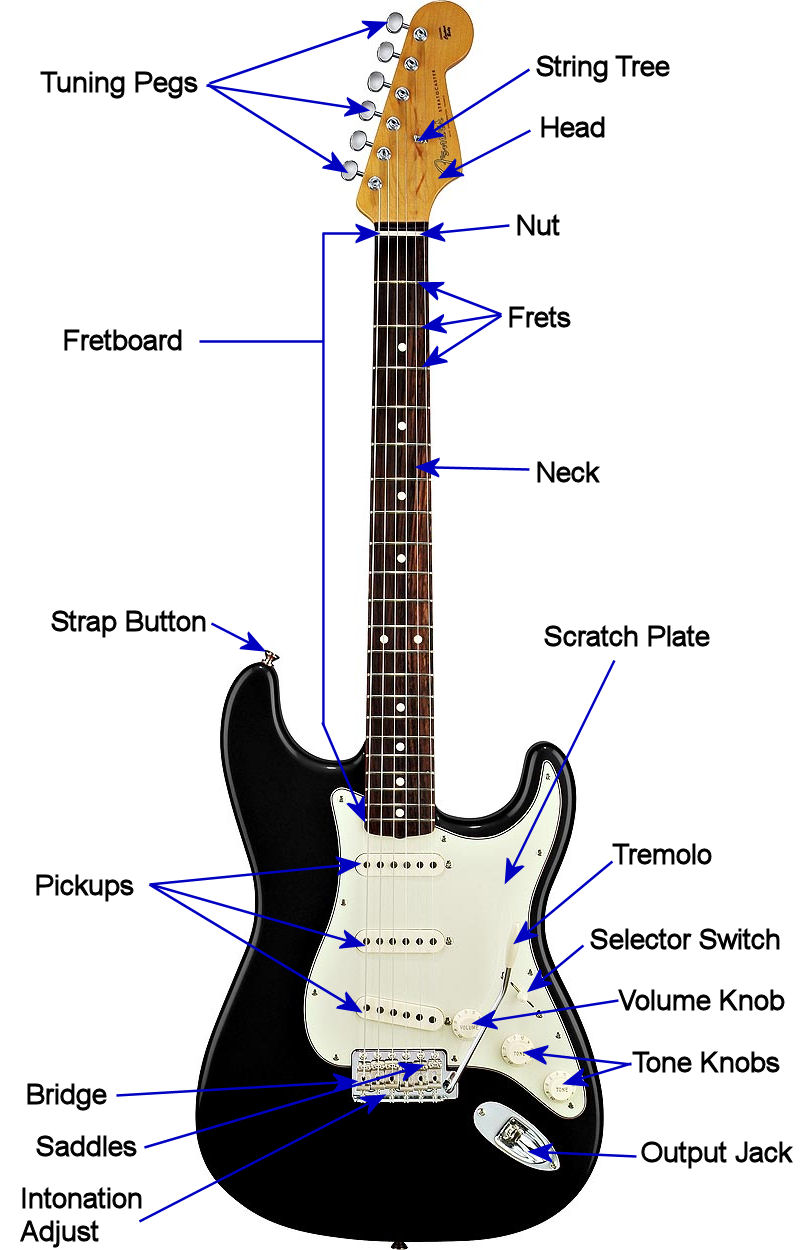
Tuning Pegs - (also known as Machine Heads) these are used to tune your guitar. On a properly setup guitar you would turn these clockwise to raise the pitch and anti-clockwise to lower it.
String Tree - the string tree is there to prevent the strings from pulling up out of the nut. Some guitars angle the head backwards so no string trees are needed, but this is harder to build so cheaper guitars particularly will have string trees.
Head - The head (or headstock) is the name for the piece of wood from the nut upwards, and exists really to locate the tuning mechanisms.
Nut - This is a piece if plastic or metal that has grooves for all the strings to go through. It acts as an anchor for the strings vibrations, but allows the string to move through it to allow tuning.
Frets - Frets are metal inserts into the neck, they are slightly raised. When you play the guitar, in order to change the pitch of the notes on a particular string, you would press down in between 2 frets. The string is then pressed onto the higher fret which acts as a stop for the string, shortening it and making it play a higher note.
Neck - The neck is the name for the piece of wood that holds the frets, from the body of the guitar at one end, up to the nut at the other.
Fretboard - (or fingerboard) is the name for the combination of the top part of the neck and the frets. It is the place where all the fingering happens, and is usually laid out as 22 or 24 frets. 24 Frets is 2 complete octaves (octaves will be explained in a later lesson). The layout of the frets is according to mathematical rules calculated to make the pitches between frets even - for that reason, the distance between each fret is slightly less, and by the time you get to the higher frets, they are pretty close together. A good knowledge of the fretboard, and what note each fret position on each string represents is something to strive for as a guitarist.
Strap Button - The strap button is a metal protrusion that you hook your strap onto so you can play whilst standing. There are two - the one shown, and another on the bottom of the guitar.
Scratch Plate (Pick Guard) - the scratch plate is usually a piece of plastic. It exists to cover up some of the electronics of the guitar and to protect the finish of the guitar from over enthusiastic pick movements.
Pickups - one of the most important parts of an electric guitar, the pickups exist to convert the vibrations of the string into an electrical signal. There are various types of pickup of which more later. Having more than one pickup gives the guitar greater versatility because you get s different sound depending where exactly on the string you place the pick up. Nearer to the neck gives a fuller more bass heavy sound, nearer to the bridge gives you a more trebly and cutting sound.
Tremolo - the tremolo mechanism consists of a movable arm and a pivot point for the bridge. Moving the tremolo arm will raise or lower the pitch of all the strings at once, and is used to give a vibrato type of effect. In fact, the word tremolo here is a complete misnomer as tremolo refers to a change in volume, but the name has stuck. The type shown here is a simple tremolo, and these often have problems with tuning. A more complex locking tremolo (often called a Floyd Rose or FR for short, after the company that made them popular) is fitted to some guitars, especially guitars intended for shredding where extreme tremolo action is far more common.
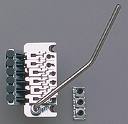
Selector Switch - the selector switch changes which of the 3 pickups is active. Most guitars with 3 pickups have a 5 way selector switch allowing you to make two pickups active at a time to blend the tone.
Volume Knob - Controls the overall output level of the guitar. Some guitars have just one volume control, others might have one volume control for each pickup.
Tone Knobs - Controls the treble and bass output of the guitar. The effectiveness of tone controls varies across guitars, some make little difference. Some guitars will have one overall tone control, others will have multiple controls.
Output Jack - This is where the electrical output of the guitar appears. Take a jack lead, plug one end in here, and the other end into your amplifier.
Bridge - The bridge overall is the mechanism that holds the strings in place at the bottom of the guitar. A little more complex than the nut, it allows a couple of different types of adjustment.
Saddles - The saddles are what stops the string vibrating at the bridge end. Similar in function to a nut, but on electric guitars, there is one saddle per string as opposed to the nut which is a single piece of plastic for all strings. The saddles can be directly adjusted to change the height of the string over the fretboard.
Intonation Adjustment - another job of the saddles is to allow adjustment of the intonation. What this really comes down to, is that for mathematical reasons, each string on the guitar needs to be a different length. The intonation adjustment is a screw that lets you move the saddle nearer to or further away from the nut, thus setting the overall length of the part of the string that vibrates.
Truss Rod (not shown) - Most electric guitars have a long metal rod built into the neck that serves two purposes. It stiffens the neck so that whilst under tension it doesn't bow, and it also allows adjustment to make the neck flat in the first place. (Actually, the correct adjustment leaves a tiny amount of curve in the neck for string clearance up and down the neck). Of all of the adjustments described in this lesson, the truss rod is the only one that has the potential to damage your guitar if incorrectly used so be careful - this adjustment is better left to a professional.
Pickup Types
The pickups shown in the guitar above are of a particular type called single coil. This was the original type of pickup, and consists of a magnet with a coil of wire wrapped around it. As the string vibrates above the poles of the magnet, it induces a small current in the coil. This current is usually fed into an amplifier where it is made much larger, and drives a speaker to devastating sonic effect. The pickup is one on the more important sonic pieces of a guitar, and you can change the sound of a guitar radically by changing the pickups for a different type. Here is a closeup of a single coil pickup.

One problem with single coil pickups is that they are susceptible to picking up electrical signals such as mains hum.This can be very annoying, so to combat this, in the 1950s Gibson invented the Humbucker pickup - so called because it bucks the hum! In construction it is pretty simple - two single coil pickups are wired together in opposite directions, so that any signal induced in opposite directions (such as the hum) will be canceled out. The real signal is not canceled because it is in the same direction in both pickups. Not only does this dramatically reduce the hum, but owing to the fact that this is two pickups instead of one, the pickup as a whole generates a larger signal. An unintended yet really important side effect of the way Humbuckers work, is that the tone they output is very different to a single coil. Humbuckers sound warm, fat and more bass heavy, whereas single coils sound more treble heavy, and cutting. Humbuckers sometimes have a plate over them that hides the fact that there is a double pickup, but you can usually spot them because they are a lot wider than single coil pickups.
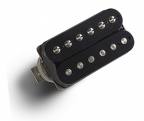
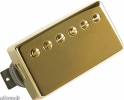
An important part of the sound of any guitar is the type of its pickups - some guitars use a single type, but many mix and match to give more versatility.
Some Popular Guitar Types
Now we have the basics, lets take a quick look at a few popular guitar types and see what they are good for. The first thing to emphasize is that any guitar can really play any type of music, the determining factor is how good the guitarist is. Having said that, various guitars are associated with particular music types, but there will always be exceptions.
Fender Stratocaster: With it bright sounding single coil pickups, the Fender Stratocaster has been used a lot for lead work by people such as Eric Clapton, or a more fusion oriented sound by the likes of Eric Johnson. Also played by David Gilmour of Pink Floyd, it is versatile, but excels at lead or cutting chord work
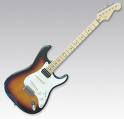
Fender Telecaster: Similar in concept to the Stratocaster, but with simpler design, the Telecaster with its single coil sound is loved by Country and Western players, yet played just as much by mainstream Rock acts. It has a distinctive twang to its sound, courtesy of its single coil pickups. Played at various times by stars such as George Harrison, Eric Clapton, and even Elvis Presley.
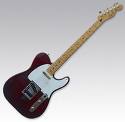
Gibson Les Paul: Marketed as the signature guitar of Les Paul (the guy who invented multitrack recording amongst other achievements), this Les Paul with its deep warm humbucker sound and notable sustain due to its heavy construction saw a resurgence in the 60s when it was picked up by rock acts in this era. Notable Les Paul players are Jimmy Page and Zack Wylde. Les Pauls are also extremely good guitars for playing blues.
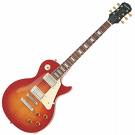
Ibanez Jem: The Ibanez Jem is a signature model of Steve Vai, but is representative of Ibanez guitars in general. Featuring a Locking Tremolo, Single Coil and Humbucker pickups in various combinations, these guitars are designed for versatility and playability. Whilst they don't have as distinctive a tone as the models mentioned above, they are versatile instruments, and often held up as archetypal shred guitars, although the truth is that you can shred on any guitar if you have the skill for it.
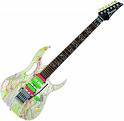
Of course there are many other guitar types, this is just a small sample, but these are the most often copied models. There is a great market in cheaper versions of these instruments, for instance Squier making Stratocaster copies, and Epiphone making copies of various Gibson guitars. In addition, there are other designs such as the Gibson SG, or Flying V that are popular for specific genres of music, often as much for image reasons as particular sounds.
That's it for this lesson - hopefully now you know which end of a guitar is which and what all the various parts are for!
Editorial note: published 2007-10-22
Posted by: botoxfox Oct 21 2007, 06:37 AM
Great work Andrew, I think a lot of beginners will benefit from this, though I think you should put some more altenative terms in there like for example machine head for tuning peg and the like. ![]()
Posted by: Andrew Cockburn Oct 21 2007, 06:41 AM
Good plan - can you think of any others? I'll start thinking too ![]()
Posted by: mattacuk Oct 21 2007, 06:42 AM
That really is an outstanding peice of work andrew - well done !! ![]()
Posted by: botoxfox Oct 21 2007, 06:48 AM
You also have tuning machines.
Posted by: tonymiro Oct 21 2007, 07:23 AM
Maybe also add a little bit about fret boards Andrew?
(Truss rod isn't there either but it might be best not to mention it or there could be zillions of newbies all trying to adjust theirs ![]() .)
.)
Cheers,
Tony
Posted by: muris Oct 21 2007, 11:32 AM
Nice thread Andrew,many will gain from it!! ![]()
Posted by: Fabian Schulz Oct 21 2007, 07:39 PM
Thank you andrew.
This really helped me a lot because i din't now the english words and always wondered what the nut could be ![]()
Posted by: Andrew Cockburn Oct 21 2007, 11:44 PM
(Truss rod isn't there either but it might be best not to mention it or there could be zillions of newbies all trying to adjust theirs
Cheers,
Tony
Your wish is my command ...
This really helped me a lot because i din't now the english words and always wondered what the nut could be
Glad it helped Fabien
Posted by: Kristofer Dahl Oct 22 2007, 06:35 PM
This is excellent Andrew! ![]()
Posted by: Jerry Arcidiacono Oct 22 2007, 07:48 PM
Thank you Andrew! Very useful.
Posted by: Andrew Cockburn Oct 22 2007, 08:20 PM
Thanks guys ![]()
Posted by: rokchik Oct 22 2007, 08:27 PM
Great job Andrew ![]()
I wish I had this when I got my first guitar. Really liked the explanation of the different pick ups.
rok
Posted by: Eat-Sleep-andJam Oct 23 2007, 04:37 AM
You just had to put the Jem in there for popular models ![]()
Nice Review ![]()
Posted by: Andrew Cockburn Oct 23 2007, 04:41 AM
Nice Review
Of course, did you doubt it??? My excuse is that its representative of Ibanez in general
Posted by: Understudy Oct 23 2007, 04:44 AM
Andrew am I missing something or did you forget the Carvin DC 127 pic ?
Posted by: swingline Oct 23 2007, 10:57 AM
I have heard a scratch plate also called a pick guard.
Posted by: Wyvernx Oct 23 2007, 11:23 AM
Cool, I had an idea of what 90% of the things were, now I get it!
Posted by: Andrew Cockburn Oct 23 2007, 07:56 PM
Thanks - adding it in!
Posted by: shammy Oct 24 2007, 11:09 AM
Well I'll be damn'd, someone ripped you off Andrew, copy and pasted this whole lesson word for word. I thought it was great when I was searching for some theory for my son, now I'm just stunned that it was hoisted from ya. great lesson.
Posted by: Kosei Kubota Oct 24 2007, 12:41 PM
Good job, Andrew. That was really informative.
I didn't know a little metal piece on the head is called string tree.
It is like a tiny tree. ![]()
Posted by: Jenkinson Oct 24 2007, 01:08 PM
I enjoyed reading the part that said turn the tuners "anti clockwise to lower pitch" instead of counter-clockwise, lol.
Posted by: tonymiro Oct 24 2007, 07:10 PM
In the UK the term used is anti-clockwise - counter clockwise is an Americanism. It's just a case of which form you are used to.
Cheers,
Tony
Posted by: Andrew Cockburn Oct 24 2007, 08:22 PM
Cheers,
Tony
And even though I am living in the USA and know the difference I used the English way
Posted by: mattacuk Oct 25 2007, 04:34 PM
Cup of Tea and all that ! ![]()
Posted by: Andrew Cockburn Oct 25 2007, 08:16 PM
Jolly good show Matt!
Posted by: julz_122 Oct 30 2007, 06:21 AM
hey andrew thx so much for the lesson really helped ![]()
Posted by: FretDancer69 Dec 8 2007, 07:23 PM
Andrew, whats the name for the small thing were u put the string in, where u coil the string?
Posted by: Milenkovic Ivan Dec 8 2007, 10:53 PM
Nice going Andrew, you sure explained well the guitar parts for newcomers. Very usefull piece of info here. I`ll remember to reference on it when newbies arive ![]()
Posted by: Andrew Cockburn Dec 9 2007, 01:45 AM
Thats part of the tuner, I'd call it atuning peg ...
Thanks Ivan
Posted by: FretDancer69 Dec 9 2007, 04:47 AM
oh ok, i thought the tunning pegs were only the ones you turn around to tune the guitar, but i was talking about the ones with the hole where the string is inserted. Well, sorry if they have the same name.
Thanks for clearing that up Andrew ![]()
Posted by: JWBauer Jan 8 2008, 04:59 AM
On the guitar styles you forgot the hollow body and semi-hollow body guitars that are popular among jazz and blues players. The rockabilly scene uses the hollowbodies extensively as well.
Posted by: moez507 Apr 1 2008, 08:38 PM
Thanks a lot!! Its great for a beginner!
Posted by: TreyDeschamp Jul 9 2008, 04:24 AM
Great work andrew!
Posted by: Andrew Cockburn Jul 9 2008, 09:58 PM
Glad you like it!
Posted by: Juan M. Valero Jul 9 2008, 10:03 PM
yeah, really interesting for me 'cos I didn't know some translations !!! ![]()
Posted by: Fusar Jul 24 2009, 06:56 PM
My first steps on the theory board ![]() when joining GMC, I thought, that I knew all these things, but I noticed that I didn't understand every word (since English is not my mother tongue)...so here I have a great translations and great and simple explanations op the parts
when joining GMC, I thought, that I knew all these things, but I noticed that I didn't understand every word (since English is not my mother tongue)...so here I have a great translations and great and simple explanations op the parts ![]() Nice job!
Nice job!
Posted by: Janos Kallai Aug 4 2009, 04:32 PM
Great work Andrew!
Very useful!
Powered by Invision Power Board (http://www.invisionboard.com)
© Invision Power Services (http://www.invisionpower.com)
